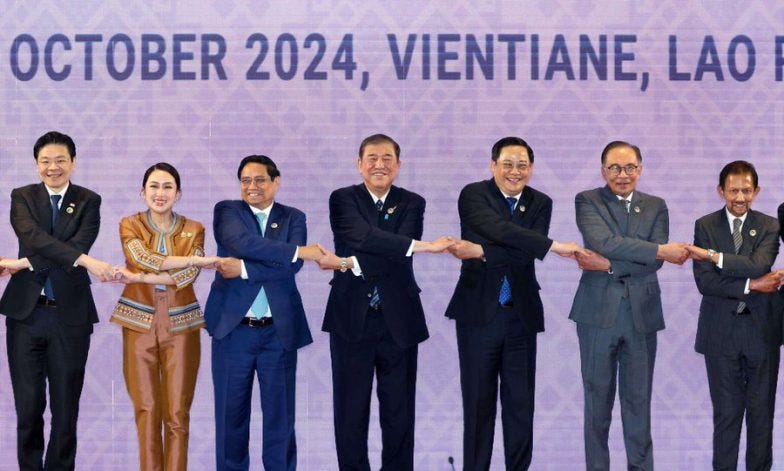
Japan’s new prime minister, Shigeru Ishiba, is stirring the pot—notably on regional security matters. He has proposed something that has done more than raise a few eyebrows in the foreign and defence ministries of several countries. An Asian version of NATO, he has suggested, was an idea worth considering, notably given China’s ambitions in the region. “The creation of an Asian version of NATO is essential to deter China by its Western allies,” he revealed to the Washington-based Hudson Institute in September.
During his campaign for office, Ishiba had mooted changes to the deployment arrangements of the Japan Self-Defence Forces and the need to move beyond the purely bilateral approach to regional security anchored by US agreements with various countries, be it with Japan, South Korea, the Philippines and others.
Ishiba’s suggested changes to Japan’s self-defence posture builds on a cabinet decision made during the Abe administration to reinterpret the country’s constitution to permit exercising the right of collective self-defence. It was a problematic move, given the pacifist nature of a text that renounces the use of force in the resolution of international disputes.
In September 2015, then Prime Minister Shinzo Abe convinced the Diet to pass a package of security bills known as the Legislation for Peace and Security, thereby allowing Japan to participate in limited forms of collective self-defence. Opponents warned, understandably, that the legislation paved the way for Japan to attack a country in concert with another on the premise of collective self-defence, despite not itself being directly attacked. They have every reason to be even more worried given Ishiba’s recent meditations.
The intention to broaden the remit of how Japan’s armed forces are deployed is also a reminder to the United States that Tokyo is no longer interested in playing a subordinate role in its alliance with Washington. “The current Japan-US security treaty,” complains Ishiba, “is structured so that the US is obligated to ‘defend’ Japan, and Japan is obligated to ‘provide bases’ to the US.” He suggests “expanding the scope of joint management of US bases in Japan”, a move that would reduce Washington’s burden, and revising the Japan-US Security Treaty and Status of Forces Agreement to permit the stationing of Japanese forces on Guam.
What makes his suggestions disconcerting is not merely the establishment of a power bloc bound by the glue of collective self-defence–an arrangement that has much to do with defence as a growling provocation. Ishiba is intent on being even more provocative in suggesting that any such “Asian version of NATO must also specifically consider America’s sharing of nuclear weapons or the introduction of nuclear weapons into the region.”
Were such a move taken, it would, at least from a Japanese perspective, fly in the face of a doctrine in place since December 1967, when Prime Minister Eisaku Sato articulated the three non-nuclear principles of “not possessing, not producing and not permitting the introduction of nuclear weapons, in line with Japan’s Peace Constitution.”
As with so many in the business of preaching about international security, false paradigms and analysis are offered from the pulpit. The Japanese PM, much like neoconservative hawks in Washington and Canberra, prove incapable of seeing conflict in generic, transferrable terms. “Ukraine today is Asia tomorrow,” he falsely reasons. “Replacing Russia with China and Ukraine and Taiwan, the absence of a collective self-defense system like NATO in Asia means that wars are likely to break out because there is no obligation for mutual defense.” Ergo, he reasons, the need for an Asian version of NATO.
Ishiba’s suggestions have yet to gather momentum. Daniel Kritenbrink, US assistant secretary of state for East Asia and the Pacific, told a forum on Indo-Pacific security at the Stimson Center in September that he preferred the current “latticework” approach to US regional alliances featuring, for instance, the Quadrilateral Security Dialogue involving Japan, India and Australia, and AUKUS, featuring Australia and the UK. “It’s too early to talk about collective security in that context, and [the creation of] more formal institutions”. It was far better to focus on “investing in the region’s existing formal architecture and continuing to build this network of formal and information relationships.”
Kritenbrink’s analysis hardly gets away from the suspicion that the “latticework” theory of US security in the Indo-Pacific is but a form of NATO in embryo. As Chinese Foreign Minister Wang Yi said with tartness in 2022, “The real goal for the [US] Indo-Pacific strategy is to establish an Indo-Pacific version of NATO. These perverse actions run counter to common aspirations of the region and are doomed to fail.”
From New Delhi, the view towards such an alliance is not a glowing one. On October 1, at an event held by Washington’s Carnegie Endowment for International Peace, Indian Foreign Minister Subrahmanyam Jaishankar proved dismissive of any NATO replication in Asia. “We don’t have that kind of strategic architecture in mind.” India had “a different history and different way of approaching” its security considerations.
With the return of Donald Trump to the White House, the collective defence hawks so keen on adding kindling to conflict will have their teeth chattering. Ishiba’s ideas may well have to be put back into cold storage—at least in the interim. And as luck would have it, his own prime ministerial tenure already looks threatened.



